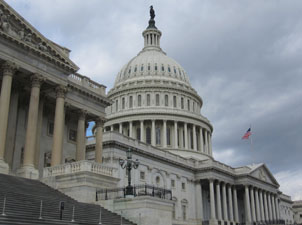
Join the #NunsOnTheBus Tax Justice Truth Tour!
[youtube https://www.youtube.com/watch?v=HOJYOR7pqwM]


[youtube https://www.youtube.com/watch?v=HOJYOR7pqwM]


In September 2018, the state of Arkansas revoked coverage for more than 4,300 Medicaid users. The state recently implemented a stringent work requirement on Medicaid recipients under the Arkansas Works program, stipulating that they must perform 80 hours of work, service, job training, or education a month. The state unceremoniously dropped recipients who did not properly log their hours into an online portal for three months. These dropped Medicaid users have no possibility of reapplying for the entirety of 2018.
This news came as a shock to the many low-income Arkansans who previously qualified for Medicaid. Due to the low profile implementation of the program, many were not aware of the new requirements. Some will not even realize they have lost their healthcare coverage until they go to the doctor or try to fill a prescription.
This is not an isolated phenomenon. Across the country, the Trump administration and its allies are encouraging burdensome work requirements for programs like Medicaid and SNAP (the Supplemental Nutritional Assistance Program). Indiana, New Hampshire, and Kentucky already received federal approval to implement their own Medicaid work requirements, while at least nine other states are considering them.
Even if Medicaid recipients in Arkansas are aware of the recent changes, they might not be able to access the Arkansas Works website to log their hours. According to the Federal Elections Commission, about a fourth of Arkansas’s population lives in areas without Internet service. The online portal has also been fraught with problems, preventing many from logging their work hours. Curiously, the website is down for 10 hours every night for maintenance, leaving it out of commission for 70 hours a week. These barriers make compliance difficult for a population already stretched thin.
It’s not as if Medicaid recipients aren’t working. At best, only 15% of enrollees not exempt from existing work requirements are not employed (Urban Institute); the vast majority are already working. The reason they are utilizing Medicaid is not due a lack of work—it is due to the deep poverty they are experiencing. Recipients do not have access to quality jobs that pay a living wage and provide health benefits.
Let’s not be mistaken—programs like Medicaid already have strict work requirements. These additional work requirements are an attempt to burden vulnerable populations with administrative barriers to affordable, quality healthcare. By dropping more than four thousand people from Medicaid coverage, the state of Arkansas stands to save 30 million a year. States like Arkansas that choose to implement these cumbersome some work requirements are choosing savings over care for their people.
Burdensome work requirements don’t address the realities of the low-income populations Medicaid serves. Work requirements don’t create stable jobs that pay a living wage, nor do they do anything to alleviate the racial income gap. Black Arkansans are twice as likely to live below poverty level than their white counterparts. These work requirements are complex in nature—they are designed to quietly dismantle social safety nets while stigmatizing low-income people as the problem. If Arkansas is serious about getting its residents off Medicaid, it needs to address economic inequality and reinvest in the working class.
The data from Arkansas gives us a look at the true human cost of burdensome work requirements. As other states roll out similar programs, thousands of people will unknowingly lose their coverage. There is no human benefit to burdensome work requirements. They only serve to harm people who utilize programs like Medicaid and SNAP to survive. NETWORK opposes implementing work requirements on our most effective human needs programs, and urges lawmakers to craft these programs to uphold human dignity, not diminish it.


This summer, Congress made extraordinary progress toward completing the requisite 12 spending measures for upcoming fiscal year (FY) 2019. To date, the Senate has passed nine spending bills, while the House has passed six. Lawmakers have until September 30 to finalize spending bills or extend funding at current levels through a continuing resolution (CR). Efforts are underway to bundle nine* out of 12 spending measures into three packages by September 30 and put the remaining three** bills into a CR, averting a government shutdown.
One reason for the Senate’s remarkable pace on appropriations is President Trump’s vow to not sign another omnibus spending bill. To achieve this progress, the Senate uncharacteristically spent part of August in session. Another reason is a bipartisan agreement between Appropriations committee Chairman Richard Shelby (R-AL) and Vice Chairman Patrick Leahy (D-VT) not to pack spending bills with controversial provisions that would weaken bipartisan support.
NETWORK continues to lead lobby efforts supporting our Mend the Gap priorities. These include: humane border enforcement that promotes family unity and funding increases for affordable housing, workforce development, job training, child welfare and health care. In addition, NETWORK will continue to oppose efforts to defund the Affordable Care Act.
Unsurprisingly, the Trump Administration’s “Zero Tolerance” immigration policy dominated the appropriations debate and faced strong opposition across party lines in both chambers. NETWORK joined pro-immigration advocates in garnering support for more than 12 amendments to the Homeland Security bill that adds report language that clamps down on family separation with better oversight and accountability standards for ICE detention centers. Additionally, we successfully lobbied for more funding to support alternatives to detention, family case management services, and mental health screening of unaccompanied minor children crossing the Southern border. However, a major disappointment by House Appropriators includes the reversal of the Flores Settlement, a 1997 agreement drafted by the ACLU which set a 20-day limit for family detention and governs the conditions of detention for children, including that facilities be safe, sanitary, and age appropriate. If enacted this would allow immigrant families to be indefinitely detained in facilities with harsh conditions not supported by Flores. Thankfully, the Senate approved LHHSED Appropriations bill leaves the Flores settlement agreement intact and the House language is not likely to be part of the final bill.
As for immigration enforcement spending contained in the Homeland Security Appropriations bill, the House Appropriations Committee approved $7 billion more than the Senate for Immigrations and Customs Enforcement (ICE), Customs and Border Patrol (CBP) and the Southwest Border Wall. Other areas of concern include, a 10 percent increase in detention beds, as well as funding to hire almost 800 more border and customs agents/officers.
NETWORK will continue to push back on efforts to separate families or that would undermine humane border enforcement as negotiations gain momentum post the mid-term elections.
The current Farm Bill is set to expire on September 30, unless Congress passes the next Farm Bill before then or extends the current reauthorization. Regardless of when Congress finalizes the next Farm Bill, funding for SNAP will not lapse as the government is statutorily required to continue funding the program subject to participation demands. Since 2015, SNAP enrollment has declined by more than 4.7 million people resulting in a $73 billion automatic appropriation for FY 2019. This is $794 million less than FY 2018 and a 10 percent reduction since FY 2015.
House appropriators gave a big boost to the Census Bureau in the FY 2019 Commerce, Justice, Science Appropriations (CJS) bill, approving nearly $1 billion more for the agency than the Senate. However, it is unclear how much of the $4.8 billion for the agency will be allocated for the 2020 Decennial. Conversely, the Senate appropriators (under new leadership) appears to have taken a more conservative approach and adopted the President’s FY 2019 budget request to fund the 2020 Decennial at $3.015 billion. This is drastically different from NETWORK’s request of $3.928 billion minimum baseline.
Besides census activities, the CJS bill also funds immigration related law enforcement and adjudication efforts within the Department of Justice. Regrettably, the House Committee bill, fails to fully protect immigrant families and includes increased funding for immigrant-related law enforcement efforts. Congress is not expected to finalize the CJS bill until sometime after the mid-term elections. NETWORK will continue to call on our supporters to push for the higher number for the 2020 Census contained in the House bill.
Funding for housing programs fared better in the Senate. The Senate approved a $12 billion increase above the President’s FY 2019 budget request−and is $1 billion above the House bill. Housing programs help nearly 5 million vulnerable families and individuals. This includes: $22.8 billion for tenant-based Section 8 vouchers; $7.5 billion for public housing; $11.7 billion for project-based Section 8; $678 million for Housing for the Elderly; and $154 million for Housing for Persons with Disabilities. Both committee bills reject the Administration’s rent reform proposal, and reinstate funding for the Community Development Block Grant (CDBG) and HOME Investment Partnerships programs, which were eliminated in the President’s FY 2019 budget request. However, the House reduces spending for the HOME program by 12 percent.
NETWORK will continue to advocate for increased funding for affordable housing programs.
The LHHSEd Appropriations bill funds popular safety net programs, like Medicare and Medicaid operations, home energy assistance, Head Start and the Child Care Development Block Grant. It is the 2nd largest spending bill, after defense and comprises about 63 percent of total discretionary spending. The House and Senate bills are slightly different—overall the Senate bill is better because it has a higher spending allocation and contains no poison pill riders unlike the House.
Unfortunately, the Affordable Care Act continues to be attacked by Republican lawmakers. Both the House and Senate bills reduce access to affordable health care by cutting funding for the Centers for Medicare and Medicaid Services (CMS) operating budget by nearly half a billion dollars. According to the House Committee report, Democrats view defunding CMS as “a misguided attempt to sabotage the Affordable Care Act’s health insurance marketplace.” If enacted this cut would significantly impact Medicare as it subject to mandatory 2 percent sequestration cut pursuant to the Balance Control Act of 2011 (P.L. 112-25).
NETWORK will continue to call on our supporters to push back against efforts to defund the Affordable Care Act.
* Agriculture; Defense; Energy and Water; Financial Services; Interior; Labor-Health and Human Services-Education; Legislative Branch; Military Construction and Veterans Affairs; Transportation and Housing and Urban Development.
**Commerce, Justice, Science; Foreign Operations; and Homeland Security.


This month has been particularly rough for the Affordable Care Act (ACA). In two acts of sabotage, the Centers for Medicare and Medicaid Services (CMS) announced policy decisions that will undermine access to health care for millions of people. (You can see our coverage of previous ACA sabotage from the Trump administration this year here).
First, the administration and the Centers for Medicare and Medicaid Services sent out a notice that funding for the navigator program would be cut to $10 million for the 2018-2019 enrollment period. Navigators work on the ground to help people navigate the online Insurance Marketplace and choose a plan that is right for them. Most navigators work for non-profit companies, and are present in congregations, public libraries, and other spaces to meet the needs of their community. Navigators also provide internet access to low-income and elderly people who might not have access to a computer find affordable health insurance. In 2016, the program was funded at $62 million, and only $36 million last year.
CMS also announced that it would be ending the risk adjustment program for insurance companies on the marketplace after a narrow ruling in New Mexico. The risk adjustment program is one of the main ways people with pre-existing and complex medical conditions can gain access to healthcare. The program uses premium money from healthy people in the individual market to pay for sicker people. It doesn’t cost anything, and is one of the main ways insurance works. Without this, however, costs could skyrocket for people with pre-existing conditions. This comes as rates and markets are being set for 2019, and without the ability to spread around risk between healthy and sick patients, premium rates could increase dramatically.
However, this decision was based on one case in New Mexico, where the judge ruled that the program in the state could not continue. Previous to this, a judge in Massachusetts had found the rule legal. However, CMS decided that the New Mexico ruling applied to all twenty-three states that have their own individual marketplace programs. Additionally, the Centers for Medicare and Medicaid Services could have done a few things, including starting the appeals process or asking if the court meant for the ruling to apply to markets outside of New Mexico, that they chose not to do.
The reduction in funding for the popular navigator program, combined with the ending of the risk adjustment program, are two more acts of sabotage against the Affordable Care Act. We are seeing time and again that what the administration cannot do through the legislative process, they are doing through the administrative one.


Last June, 26 year-old Alec Smith of Minnesota died because he could not afford to treat his Type 1 diabetes with insulin that has risen in price over 1,000% since the late 1990s. One out of every five Americans does not fill a prescription each year because they can’t afford it—and risk strokes, heart attacks and unrelenting pain as a result.
Tobeka Daki of South Africa, the mother of two sons, died in 2016 because she could not afford a monopoly-protected cancer medicine priced at 193 times its manufacturing cost. The United Nations estimates that 10 million people each year die because they cannot afford the medicine to treat them.
The tragic stories of Alec Smith and Tobeka Daki could be repeated many times over in every community, and they could be told about vaccines, mental health medicines, asthma medication and nearly every other treatment. Many of us heard about the Epi-Pen 450% price increases or “Pharma Bro” Martin Shkreli’s 5,000% overnight spike in the price of the HIV medicine Daraprim. But these high-profile controversies are only the most visible symptoms of a deeply entrenched problem.
In stark contrast to Jesus bringing healing to the poorest of the poor, today’s lifesaving treatments have increasingly become a luxury that only the world’s wealthy can afford. Protected from market competition by monopoly patents, medicines are routinely priced at levels hundreds of times their manufacturing costs. The companies that sell the medicines make record-breaking profits yet still routinely raise prices by double-digit margins each year.
These companies tout their research investments, but they actually spend far more on advertising, executive salaries as high as $78 million per year, stock buybacks that enrich the top shareholders, and political campaign donations. In the meantime, our sisters and brothers are splitting their pills, maxing out credit cards just to go to the pharmacy, or simply going without their medication.
For people of faith, this status quo is unacceptable. All major religious and moral traditions embrace a clear responsibility to care for those who are poor and the sick. And that obligation goes beyond direct care to use our voices to ensure that our systems and laws do not lock out those in desperate need of medicines.
So it is not surprising that a significant majority of Americans are demanding drug pricing reform. And we have an opportunity to make it happen. Bipartisan proposals to change the system are pending in dozens of states and Congress.
Those proposals include allowing Medicare to negotiate drug prices the same way other countries do now, and speeding the process for drugs to be available at far cheaper generic prices. The corporations setting record prices can do so only because our government has chosen to grant them private monopolies on selling taxpayer-funded developed medicines, even though nonprofit models for research and development have proven to be effective.
Advocates for affordable medicines have won before. In the HIV/AIDS treatment campaign of the turn of the century, much of the faith community joined a global moral movement that successfully overcame monopolies and reduced antiretroviral medicine prices by more than 90%, saving millions of lives in the process.
The faith community can play this role again. We start with the foundation, set out in both our sacred texts and global human rights treaties, that people who are suffering should be able to access the medicines they need. The fact that Alec Smith, Tobeka Daki and millions of others cannot access the medicine they need to live is a moral failing.
But we can fix this, and people of faith can help lead the way.
Fran Quigley is a NETWORK advocate based in Indiana and the coordinator of People of Faith for Access to Medicines (PFAM).
Do you have a personal story about drug prices that you’d like to share with NETWORK as we advocate for affordable medicine? Submit your story below. Thank you!


Over the past few months, we have seen continued attacks and outright sabotage on the Affordable Care Act (ACA) from the Trump administration. After last summer’s failed attempt to repeal and replace the Affordable Care Act through a bill sponsored by Senators Lindsey Graham (R-SC) and Bill Cassidy (R-LA), the administration moved to try and end protections through the rule-making process in the department of Health and Human Services. While the implications of the new rules are serious, and will likely cause millions of people to lose or be priced out of healthcare coverage, there is a new legislative threat looming that is eerily similar to the Graham-Cassidy plan that we saw last summer.
This plan was introduced recently by the conservative Heritage Foundation and former Senator Rick Santorum and later presented to Republican leaders. Most of the plan is the same as what we saw last summer in the Graham-Cassidy proposal. It would undo protections for those with pre-existing conditions, include annual and lifetime limits, and exclude certain essential services in health insurance plans, including maternity and mental health services.1 Additionally, it would undo Medicaid expansion and convert Medicaid funding to a block grant to the states, making it less likely that low income people will be able to access affordable coverage.1
The good news is that this is still just an idea from a conservative think tank. However, as we have seen before, Republicans in the House are serious about taking away healthcare coverage and protections from the most vulnerable.
There is concern that if this horrible idea becomes a bill, it could move quickly this summer due to a process called budget reconciliation. In this process, the budget could include instructions that would allow for Congress to pass a bill with only 51 votes, instead of the normal 60 vote majority. This is what happened last summer when the “repeal and replace” bills nearly passed in the Senate.
As people of faith, we believe that healthcare is a human right. When proposals like this threaten to take away access to healthcare from the most vulnerable among us, we will fight to stop it. We will be monitoring this situation closely to ensure that this proposal does not become a bill. If it does become a bill, we will mobilize and act to prevent it taking healthcare away from millions.


I first learned about NETWORK through Dignity Health. Dignity Health is one of the largest healthcare systems in the nation. Its mission is to deliver compassionate, high quality, affordable health care service—especially to those who are poor and vulnerable. Advocacy is central to its mission, and NETWORK has been a longtime partner in helping the organization to advance its policy priorities. As the Director of Public Policy & Community Advocacy, I can’t imagine being able to do my work without our collaboration with NETWORK.
To sum it up, it’s the Sister-Spirit that inspires me and that continually draws me in. I’ve been so fortunate to grow up (and be raised by) incredible women religious. They’ve shaped my love for people and community since I was a little girl—through my formative years in elementary school and high school. And as I came to Dignity Health as a young mother and someone starting out in a career in Catholic healthcare, it was always the Sister-Spirit that moved me, made most sense to me, and gave me the reason for why and how I’m called to this work.
Other than health and healthcare, I’m most passionate about immigration, equity issues (homelessness and poverty), and the environment. As an immigrant to this country from the Philippines at age of five, I have a deep understanding of what it means to be “the other,” to be displaced and to be indebted (this utang ng loob, literally translated in Tagalog means, “a debt of one’s inner self”). All this while continuing to practice what it means to be authentically one’s self, value this broader sense of being home, and give back to and cherish community. There is so much suffering in our neighborhoods, our nation, and our world today. I believe that our passions direct us to seek justice, build meaningful connections, and experience joy and love.
I get to wake up to the best job in the world. I wouldn’t even call it work, except that I actually get paid for doing something I love. At Dignity Health, I get to live out my passions, work on social justice issues at both the legislative/regulatory policy and community levels, mobilize grassroots advocacy efforts, and partner with so many amazing organizations, businesses, and leaders of all sorts of shapes, sizes, and backgrounds.
I’m often on a plane these days and I never seem to tire looking out of the window—the view still takes my breath away. The sun sometimes gets too bright or the darkness too mysterious and I have to put the window cover down. And so I close my eyes to reflect and pray. Life is so precious. Every day that we get to have to be in it, to be a part of it, and do our part for it—makes me feel so blessed. Advocacy is more than just seeking social justice; it’s actually experiencing this incredible gift in the world called humanity.
Faith is all things quite alive in and around me, and is also in those things in between that seem like contradictions—that in the moment can’t get quite pinned down by time. In a word, faith is everything to me. Faith lets me know that the work I do to advance justice matters—that it’s meaningful and that there’s more work still to be done.
Wow, to pick one would be impossible for me. Every day, at every turn, there is someone or even something that inspires me and that I want to practice to become. Like my dad, who is recovering from a stroke and who I see fighting his way back from paralysis to walk again; like Sister Regina Ann, who I got to know during a break at a NETWORK Board retreat while we sat under a dogwood tree as if the chaos of time stopped for a moment so we could enjoy the beautiful spring afternoon; like my children, Keana Sky and Tristan Blue, who show me the resilience and unbreakable bond of love.
I recently gave a TedTalk style presentation at the closing plenary session of a CleanMed conference, since titled “Finding Your Voice in the Climate Story.” And there was this one quote from Nigerian storyteller Chimanda Ngozi Adichie that I included: “The single story creates stereotypes. And the problem with stereotypes is not that they are untrue, but that they are incomplete. They make one story become the only story…The consequence of the single story is this: … It makes our recognition of our equal humanity difficult.”
It’s just such a powerful way of recognizing what harm we do to ourselves and each other when we fall for the single story. How truly precious everyone’s voice is and how our own story contributes to the greater story of what is humanity.
There are lessons to be gained from all the modern day social movements. The one I’m most interested in right now is how our country will continue to grapple with healthcare so that it is accessible and affordable to all. We’ve been able to make gains, but we’ve also made some steps backwards. What inspires me most are the many women and men that work day in and day out to care for others—despite the political winds, despite the brokenness still of our nation’s healthcare system, despite the long road ahead to one day get to a place where we no longer look at healthcare solely as a human right, but as something everyone can depend on during their time of need.


On Wednesday, June 6 NETWORK and 17 other faith-based organizations sent a letter to Congress to oppose H.R.3, which includes 7 billion dollars in cuts to CHIP as a part of the rescission process.
June 6, 2018
Dear Representative:
We, the undersigned 18 organizations, representing various religious denominations, urge you to vote NO on H.R. 3, the Spending Cuts to Expired and Unnecessary Programs Act. As currently written, this measure contains a harmful provision that would rescind $7 billion in funding for the Children’s Health Insurance Program (“CHIP”). As people of faith we believe that healthcare is a human right and that care for children is a sacred responsibility. If enacted, this rescission to CHIP would threaten the health and well-being of the 9 million children who utilize the program every year.
We are especially concerned with the $2 billion in cuts to the CHIP contingency fund. This fund has consistently been used in times of economic downturn, natural disaster, and other uncertain times to ensure that children can have access to healthcare. More recently, a similar fund was used when Congress was unable to pass a CHIP funding bill before individual state funding for the program ran out. If this fund was not available during the reauthorization process last year, thousands of children would have lost healthcare while Congress failed to act. Congress should not take away this vital security measure for the health of our children.
Recent Congressional action to pass a 10-year extension of CHIP was a major success for the 115th Congress, but this risky rescission could undercut the program and undermine this success. CHIP, as it is currently funded, is projected to decrease the deficit by $6 billion over 10 years.1 The health of our children is too important to be used as additional means to pay down the deficit. It is especially relevant to protect our children from additional cuts after the passage of the tax bill provided enormous benefits to the wealthy and large corporations while adding over $1.7 trillion to the deficit. Children must not pay for the enrichment of the wealthiest in our nation.
CHIP has enjoyed bipartisan support and success for more than 20 years. It has proven to be an effective investment in the health of our children and should be protected and supported. Our faith traditions teach us to protect the most vulnerable people, especially children. We believe that a rescissions package that threatens to take healthcare away from children does not live up to our moral obligation. We urge you reject and refuse a vote on H.R. 3, until and unless these harmful CHIP cuts are removed.
Sincerely,
American Muslim Health Professionals
Congregation of Our Lady of Charity of the Good Shepherd, US Provinces
Evangelical Lutheran Church in America
Faith in Public Life
Franciscan Action Network
Hadassah, The Women’s Zionist Organization of America, Inc.
Interfaith Worker Justice
National Advocacy Center of the Sisters of the Good Shepherd
National Council of Churches
National Council of Jewish Women
NETWORK Lobby for Catholic Social Justice
Poligon Education Fund
Religious Institute
Union for Reform Judaism
Unitarian Universalist Association
Unitarian Universalists for Social Justice
Unitarian Universalist Women’s Federation
United Methodist Church – General Board of Church and Society
1. Congressional Budget Office. “Cost Estimate of Extending Funding for the Children’s Health Insurance Program for Ten Years”. January 11, 2018.


I learned about NETWORK from the Ursuline Sisters of Cleveland Social Justice Office when I first entered the community. NETWORK has informed and educated me on many social justice issues, which in turn has empowered me to do advocacy work.
I was inspired to take action with Nuns on the Bus in 2016. The goal of the trip was “to bring a politics of inclusion to divided places, change the conversation to mending the vast economic and social divides in our country, and counter political incivility with a message of inclusion.” Our world is in great need of this and I believe it is important to advocate for systemic change that seeks to address the needs of our brothers and sisters who are underserved. What better way to do this than travel the country to listen to the realities and lived experiences of people in our own communities—and then take those stories to our elected officials and encourage them to legislate for the common good.
Housing, healthcare and advocating for a faithful budget.
My faith has deeply inspired my work for peace and justice. As an Ursuline Sister of Cleveland, the story and legacy of martyrs Dorothy Kazel, Ita Ford, Maura Clarke and Jean Donovan have had a tremendous impact on my call to work for systemic change in our world. Even though I was not yet born when the women were killed, their history and legacy shared with me by my sisters has formed and shaped me as a woman religious. We must continue the work of those who have gone before us—and be faithful to the call as women of faith, committed to contemplation, justice and compassion in all we do.
“If you have come here to help me you are wasting your time, but if you have come because your liberation is bound up with mine, then let us work together.” Lilla Watson
The youth of our world who are standing up and allowing their voices to be heard on critical issues. I am so inspired and filled with hope witnessing the good work of the next generation.
Erin Zubal is an Ursuline Sister of Cleveland. She currently serves as Guidance Counselor at Cleveland Central Catholic High School in Cleveland, Ohio.


Just as supporters of the Children’s Health Insurance Program (CHIP) thought they could relax after the popular health insurance program was renewed for ten years with bipartisan support, Congress is again threatening to cut funding. This past winter, months after federal CHIP funding expired, families waited nervously as funds began to run low and states started to send out notices to families, warning them of the possible end of the program. At the eleventh hour, funding for the program was approved, and families across the country let out a collective sigh of relief.
Now, however, there is a new threat to CHIP. Last week, the Trump administration sent a request to Congress to begin a rescissions process. This is something that hasn’t been done since President Clinton, and is a bit complicated. At the President’s request, Congress has 45 days to take back money they previously allocated. They need to pass this by a majority vote, but they also have the option to not take back any of the money.
President Trump’s rescission request asked Congress to take back $7 billion from the CHIP program, along with money from some other social safety net programs, including housing. Some of the money (around $5 billion) is money that had been given to the states but was not spent. In programs like CHIP, more money is given to the states than what is expected to be needed, in case of increased expenses and these extra funds are usually re-appropriated to other health and human services programs if they are not used.
The other $2 billion is money that is set aside in what is called a contingency fund. This is money that can be used in the case of an emergency, like a natural disaster, or Congress failing to fund the program in a timely manner. Last winter, this was the fund that was used to help ensure kids in the program continued to have coverage while Congress stalled on funding the program.
White House officials argue that the money is unlikely to be used, and wouldn’t take healthcare away from kids. However, without the contingency fund last year, millions of children would have lost healthcare coverage. And while some of the money has not been used, it has traditionally been absorbed back into other healthcare programs that need it.
Instead, this funding President Trump requested to have taken away from CHIP will be used to drive down the deficit caused by last fall’s $1.3 trillion tax cut. After giving tax breaks to millionaires, Congress has faced pressure on the huge deficit it created and decided to try and decrease the deficit by taking money from CHIP. While the rescission package isn’t guaranteed to take healthcare away from children, the damage this will do is enough to make families nervous. After last winter’s unfortunate CHIP battle, families deserve peace of mind about their children’s health insurance, not further cuts to undo the damage caused by tax cuts for millionaires.
